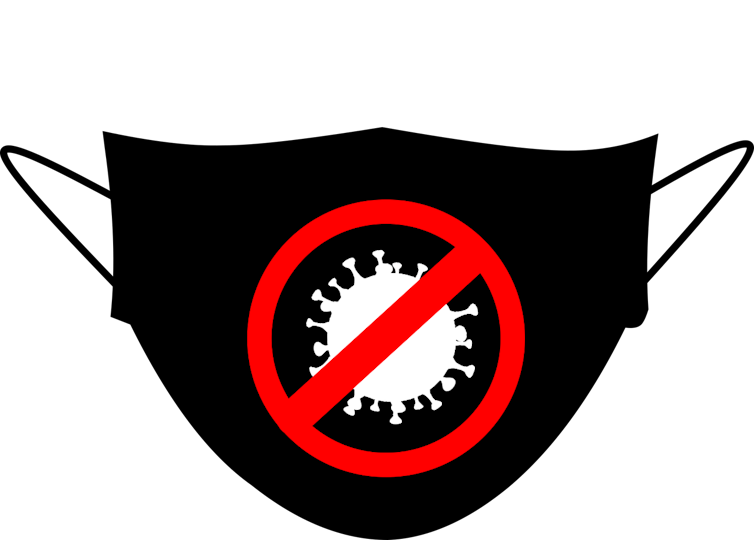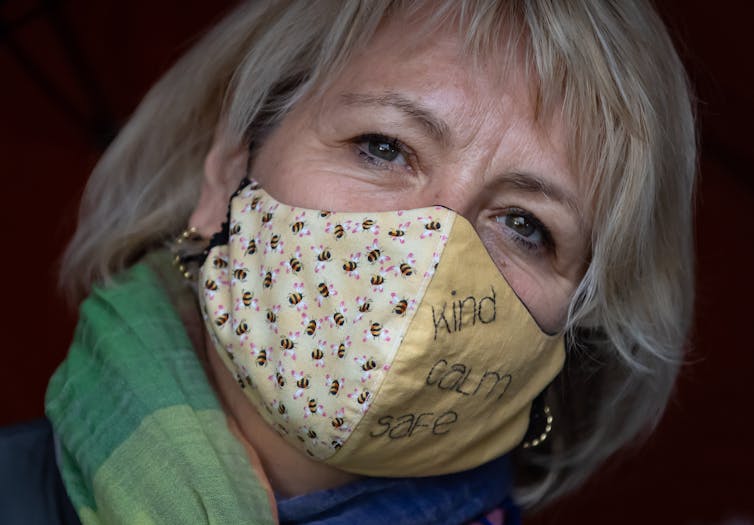Face masks reduce the spread of viruses passed on from respiratory secretions. While cloth masks are imperfect, widespread use of an imperfect mask has the potential to make a big difference in transmission of the virus.
We started reading the research on cloth masks and face coverings at the start of the pandemic, looking for ways to protect our vulnerable dialysis patients and our dialysis staff. We found a total of 25 studies, advocated for mask use and summarized our findings in a peer-reviewed publication. We also created an evidence-based, plain-language website (www.clothmasks.ca) to help people navigate this area.
Although mask use has been widely adopted, many people still have questions about them.
I see spaces in the cloth. How can it stop particles?
The virus that causes COVID-19 is about 0.1 micrometer in diameter. (A micrometer (µm) is one one-thousandth of a millimeter.) The holes in woven cloth are visible to the naked eye and may be five to 200 micrometers in diameter. It is counter-intuitive that cloth can be useful in this setting — it’s been compared to putting up a chain-link fence to stop mosquitoes. However, that analogy is wrong in many ways.
According to aerosol science, whenever liquid hangs in air it is technically an aerosol, but other disciplines use the word “droplet” to mean a coarse particle five micrometers or larger, and reserve “aerosol” for fine particles smaller than five micrometers in effective diameter.
When we breathe, talk, eat, cough, sneeze or sing, we emit particles across a range of sizes, both coarse and fine, and the virus is in those particles. Even though there are gaps between the threads in cloth, the threads are usually wider than the gaps.
Also, at this microscopic level, the thread has thickness, or depth, so the gap is more a tunnel than a window. Microfilaments from broken or irregular threads project into the gap. The particle is not like a mosquito, which can redirect itself to avoid obstacles. A particle with momentum will run into a fibre, even though the air stream is diverted around it, like a ball hitting a wall — this is called impaction.

THE CANADIAN PRESS/Ryan Remiorz
But at the microscopic level, there are two additional processes in play. Particles also fall out of the air — called sedimentation. Some particles are moving randomly and this random motion brings them into contact with fibres — called diffusion. Finally, cloth can be used in multiple layers, adding a second and third gauntlet for the particle to run before it reaches the other side.
The point is not that some particles may penetrate the cloth, but that some are blocked.
What are the best materials for cloth face masks?
Based on our summary of 25 different studies, woven cotton, at least 100 threads per inch; flannel, either cotton or poly-cotton blend, at least 90 threads per inch; tea towel material; and heavy, good quality, cotton T-shirt material all performed well. This recommendation is based on the published data available, which doesn’t cover all possible mask materials: we didn’t find a lot of information on synthetic materials, for example, so we don’t know how they compare.

(Pixabay)
Every study that looked at layering found that it made a difference, so we recommend that masks be made of at least two layers; three or four may be even better. We found evidence for multiple layers of the same fabrics and for sandwiches of different materials. We did not find good evidence of useful levels of filtration for disposable filters, like coffee filters, so we suggest not using them.
For example, a two-layer T-shirt mask with a sewn edge — which prevents stretching — prevented 79 per cent of mouth bacteria reaching the environment during coughing. In the same experiment, a modern disposable medical mask performed in the same range at 85 per cent.
Two studies of surgical masks from the 1960s and 1970s distinguished between coarse particles (sometimes called droplets) and fine particles (sometimes called aerosols). A four-layer cotton mask and a mask made of a sandwich of cotton and flannel both reduced mouth bacteria in particles of all sizes reaching the environment during talking by 99 per cent and mouth bacteria in fine particles by 89 per cent.
This is all good evidence that cloth face coverings can prevent respiratory secretions from reaching the environment. Every coarse or fine particle trapped in a mask is not available to hang in the air or fall to a surface and contaminate it. “My mask protects you, your mask protects me”: if many people wear face coverings we expect the probability of transmission to fall.
Can a cloth mask protect the person wearing it?
We found four studies of inward filtration, all of which showed useful levels of filtration, all using the same widely-accepted technology that measures salt particles in the fine particle (0.02 to 1.0 micrometer) range. A study of one-layer tea-towel masks and a study of two-layer masks made of T-shirt material both showed at least 50 per cent protection for fine particles. Two cloth masks of unknown materials randomly purchased from street vendors performed just as well. For comparison, two of these studies — using exactly the same methods — examined how well modern disposable medical masks worked when tested on volunteers: they filtered around 80 per cent of fine particles.
Three researchers from the University of Pittsburgh made complex masks with eight layers of pre-shrunk high-quality cotton T-shirts fitted to their own faces: each filtered more than 90 per cent of inward aerosol-sized fine particles, offering proof-of-concept for the idea of designing better cloth masks.

(Pixabay)
An animal experiment with tuberculosis bacteria provides further insight. Tuberculosis is usually considered an “airborne” disease, that is, one with an important transmission route through aerosols or fine particles. When caring for tuberculosis patients, health-care workers wear N95 masks, a high level of respiratory protection, to protect themselves and prevent onward transmission to others. When rabbits were exposed to aerosols of tuberculosis in controlled conditions, tuberculomas (infected abscesses) were reduced by 95 per cent in rabbits that wore close-fitting three- to six-layer gauze masks compared with those that did not.
Many of the cloth masks in current use, therefore, are likely producing useful levels of filtration to the person wearing them, and we have proof-of-concept for improved cloth mask materials and design.
At what rate of use do masks become beneficial?
Two modelling studies predict that 50 per cent adoption of a 50 per cent effective mask will have an important effect on transmission, and that if either percentage is increased, transmission is further reduced. We need to work on making cloth masks more effective, but the masks that we have on hand have the potential to change the course of the pandemic, particularly if we almost all wear them.
Mask mandates were imposed at different times in different states in the United States, creating a natural experiment. The COVID-19 daily growth rate fell by one per cent in the first five days and by two per cent at 21 days after a mask mandate was imposed. These effects are not small: they represent 16 to 19 per cent of the effects of other much more invasive measures (school closures, bans on large gatherings, shelter-in-place orders and closures of restaurants, bars and entertainment venues).
Taken together, this suggests that cloth face coverings of the type currently available have the potential to reduce transmission, and that when cloth face coverings are mandated, the growth rate decreases. The Institute for Health Metrics and Evaluation in Seattle projected on Sept. 3 that an increase in mask usage from the current 60 per cent to 95 per cent, combined with enhanced local social distancing as needed, would reduce global deaths by three-quarters of a million people before the end of 2020.
Are there any other benefits to wearing a mask?

THE CANADIAN PRESS/Darryl Dyck
A new hypothesis advanced by researchers at the University of California San Francisco suggests that cloth masks don’t just reduce the probability of infectious organisms reaching a person, but also the number of infectious organisms — and that a lower number of infecting organisms leads to less severe disease.
Accumulating epidemiologic evidence from this pandemic suggests that when masks are worn, the overall severity of illness is lower. The proportion of those infected who remain asymptomatic is higher, and the probability of dying is lower. In animal experiments it is well known that the inoculum (the infecting dose) is related to disease severity. The threshold at which 50 per cent of animals in a group receiving the same dose die of infection is called the lethal-dose 50 (LD50).
Experiments on mice using the coronaviruses MERS-CoV (Middle East respiratory syndrome) and SARS-CoV-1, which caused the 2003 SARS outbreak, showed dose-response and in MERS-CoV established LD50. In hamsters separated by surgical masks between cages from hamsters infected with SARS-CoV-2, the severity of infection was reduced compared with hamsters unprotected by masks.
Further research on better cloth masks will be helpful. At the Centre of Excellence for Protective Equipment and Materials at McMaster, we hope to play a role in that work. However, even imperfect uptake and imperfect use of imperfect masks has the potential to have a surprisingly large impact during this pandemic. We should not let the perfect be the enemy of the good.![]()
Catherine Clase, Physician, epidemiologist, associate professor, McMaster University; Edouard Fu, MD/PhD Candidate in Clinical Epidemiology, Leiden University, and Juan Jesus Carrero, Professor of Epidemiology, Karolinska Institute. This article is republished from The Conversation under a Creative Commons license. Read the original article.










